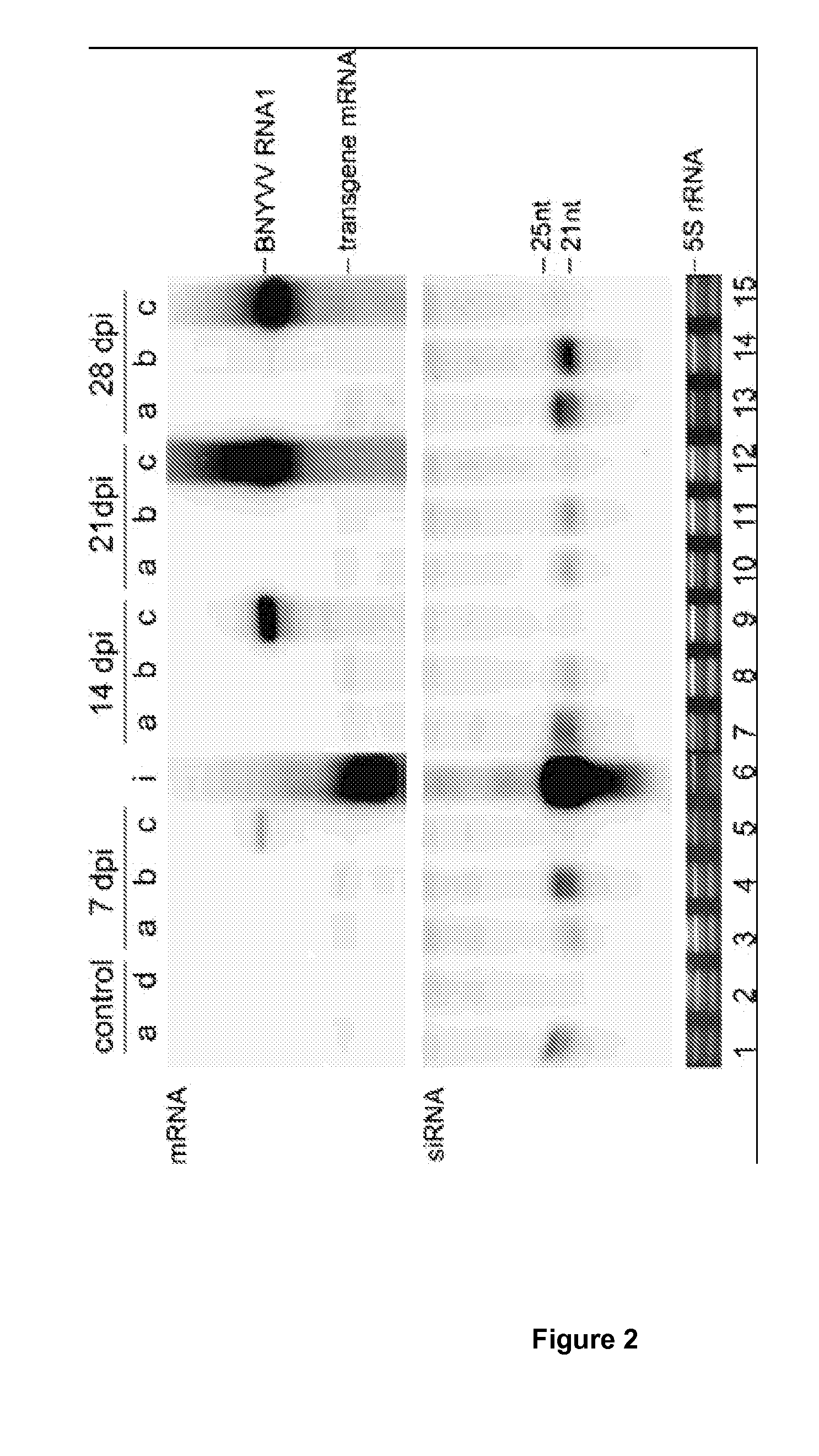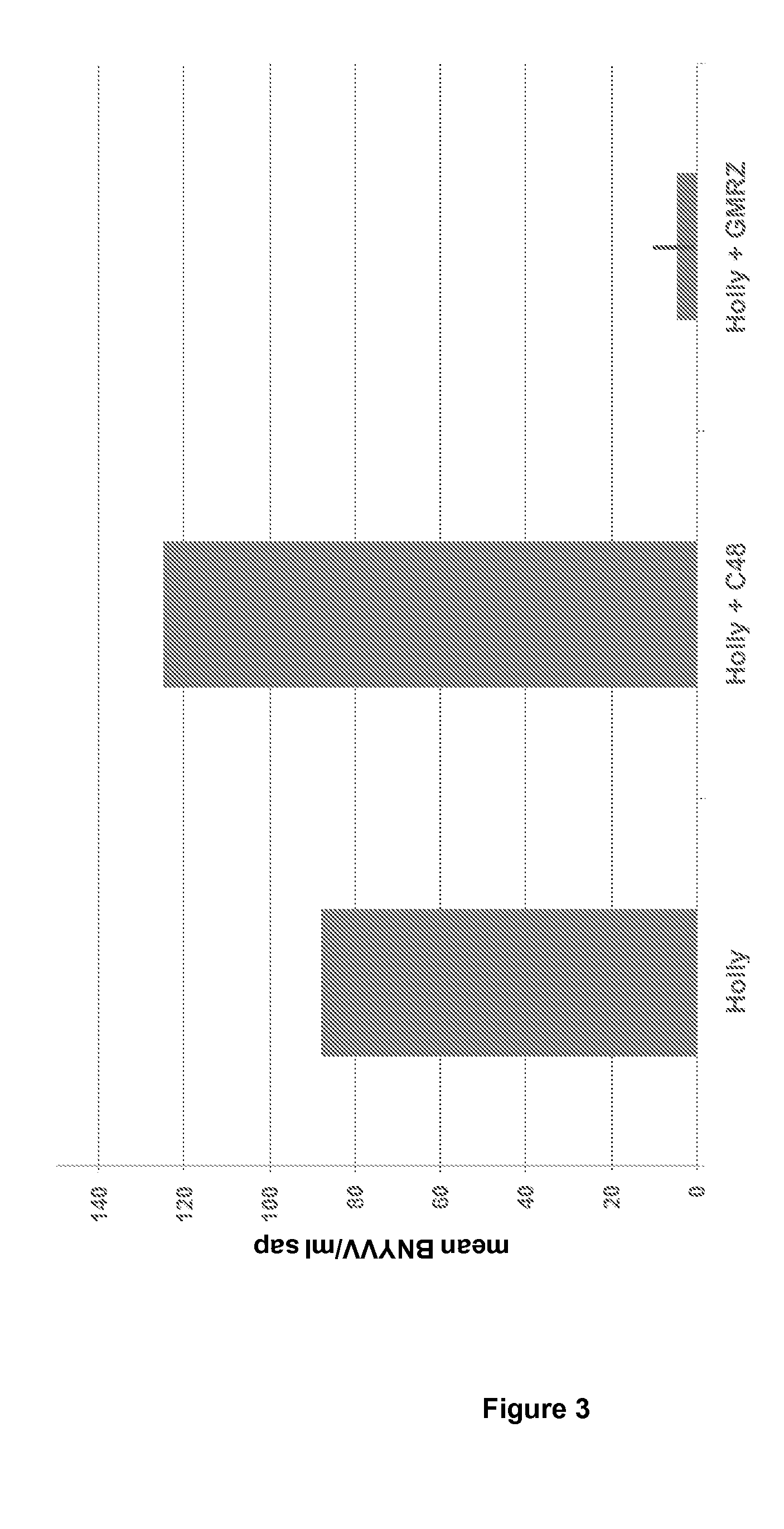Transgenic sugar beet event gm rz13
a technology of transgenic sugar beets and events, applied in the field of new transgenic sugar beet events, can solve the problems of not providing field trials data, unable to obtain the same from skilled people, and unable to provide field trials data
- Summary
- Abstract
- Description
- Claims
- Application Information
AI Technical Summary
Benefits of technology
Problems solved by technology
Method used
Image
Examples
example 1
Vector Construction
[0187]Sugar beet roots infected with the B-type of BNYVV were collected from the Harting region in Germany and total RNA was extracted using the RNeasy Plant Mini kit from Qiagen following the supplier's instruction. BNYVV RNA1 encoding the BNYVV replicase was converted into cDNA using the SUPERSCRIPT™ II RNase H-reverse transcriptase from Life Technologies, essentially as described by the supplier, and using oligonucleotide HiNK285 (5′-TCGTAGAAGAGAATTCACCCAAACTATCC-3′, SEQ ID NO: 28) as reverse primer. Subsequently, the ultimate 1.4 kb of RNA1 spanning the region harboring the GDD motif to the 3′ UTR was amplified using primer HiNK283 (5′-AAGAATTGCAGGATCCACA-GGCTCGGTAC-3′, SEQ ID NO: 29) in combination with HiNK285 in a standard PCR reaction. The sequence of BNYVV RNA1 with accession number X05147 (Bouzoubaa et al., 1987) was used as reference for the design of the various oligonucleotides, recognition sequences of restriction enzymes BamHI and EcoRI in the prime...
example 2
Transformation and In Vitro Selection of Transgenic Shoots
[0188]A conventional, rhizomania susceptible breeding line from Syngenta Seeds AB, Landskrona, Sweden, referred to as G018 was used as acceptor for transformation. Sugar beet seeds were surface-sterilized and germinated in vitro. Agrobacterium-mediated transformation of cotyledonary node explants using mannose isomerase as selectable marker gene was carried out essentially as described by Joersbo et al. (1998). Selection of transgenic sugar beet shoots was started 2-4 days after co-cultivation by gradually substituting sucrose by D-mannose to a final concentration of 12 g / L as predominant carbohydrate source in the regeneration medium. The selective regeneration yielded transgenic shoots in 12-15 weeks. To verify that the shoots were transgenic, several leaf tips from each of the regenerated shoots were harvested and the phosphomannose isomerase (PMI) activity measured using a coupled enzyme assay described by Joersbo et al. ...
example 3
Analysis of Transgene mRNA and siRNA Accumulation
[0189]Seedlings obtained in Example 2 were sown in sterile sand and subsequently transplanted into tubes containing 0.25 L sterile sand or soil infested with the B-type of BNYVV. For the detection of transgene mRNA and siRNA, root samples (0.2 g per plant) were collected at 0, 7, 14, 21 and 28 days post-transplantation (post-inoculation, dpi). In some cases roots from a few plants were pooled to achieve a sample weight of 0.2 g. Control samples containing transgene-specific siRNA and mRNA were generated by infiltrating Agrobacterium tumefaciens strain EHA101 containing pHiNK188 into Nicotiana benthamiana leaves according to the method of Johansen and Carrington (2001).
[0190]Total RNA was extracted from sugar beet roots or the infiltrated N. benthamiana leaves using a previously described protocol (Kreuze et al., 2005). The fraction of high molecular weight (HMW) RNA was used for the detection of transgene mRNA and viral RNA. The low m...
PUM
| Property | Measurement | Unit |
|---|---|---|
| Tm | aaaaa | aaaaa |
| temperature | aaaaa | aaaaa |
| pH | aaaaa | aaaaa |
Abstract
Description
Claims
Application Information
 Login to View More
Login to View More - R&D
- Intellectual Property
- Life Sciences
- Materials
- Tech Scout
- Unparalleled Data Quality
- Higher Quality Content
- 60% Fewer Hallucinations
Browse by: Latest US Patents, China's latest patents, Technical Efficacy Thesaurus, Application Domain, Technology Topic, Popular Technical Reports.
© 2025 PatSnap. All rights reserved.Legal|Privacy policy|Modern Slavery Act Transparency Statement|Sitemap|About US| Contact US: help@patsnap.com



